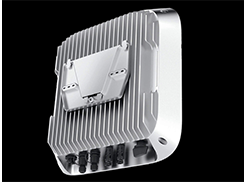Improper control of the aluminum profile filling and extrusion process will bring final defects to the product. When the ratio between the length and diameter of the ingot is too large, the filling (upsetting) process of the ingot in the extrusion barrel is similar to the free upsetting of a cylinder, and double drum-shaped deformation will also occur along the length of the ingot, such as As shown in Figure 2-31.
Figure 2-31 Double drum deformation when filling long ingots. Due to the influence of the sealing of the extrusion barrel, a closed space is first formed between the middle part of the extrusion barrel and the ingot, and the gas stays in the closed space. As the filling process proceeds, The volume of the closed space decreases and the gas pressure increases. After the filling process is completed, the shrinking gas will enter the micro-cracks on the surface of the ingot. Some of these micro-cracks carrying gas are welded when passing through the die holes, forming bubbles on the surface of the product. The micro-cracks that failed to weld flow out of the die hole and form peeling.
Sometimes due to improper operation of the filling process, even if the aspect ratio of the ingot is within the ideal range, a single drum shape may be formed during the filling process, and a closed space with air may be formed in a certain part, which will also cause bubbles and cracks to the extruded products. Skin defects. The larger the filling coefficient, the larger the gap between the ingot and the inner wall of the extrusion barrel, the greater the possibility of defects and the more serious the possibility of defects. Therefore, in general, it is hoped that the filling coefficient should be as small as possible, but the principle must be that the ingot can be smoothly loaded into the extrusion barrel. Another way to solve the defects caused by the filling process to the product is to use the gradient heating method of the billet. When the billet is heated, the temperature at the head end is high and the temperature at the tail end is low. When filling, the head deforms first, and the gas in the barrel passes through the pad. The gap between the sheet and the extrusion barrel is gradually discharged, as shown in Figure 2-32.
Since the head end of the product is formed by filling the ingot metal during the filling stage, part of the head end product flows into the die hole without deformation or with little deformation. This deformation characteristic causes the structure of the head of the product to be a cast structure or an undeformed structure, with poor performance. Therefore, the head of the extruded product needs to be removed. The larger the filling coefficient or the smaller the extrusion coefficient, the larger the head of the product needs to be removed.


